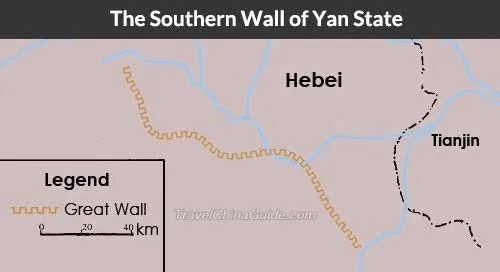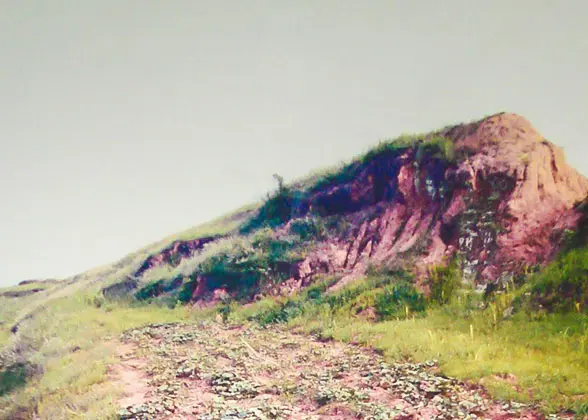Great Wall of Yan State
 |
| Yan State Southern Great Wall Map |
Yan State was one of the seven most powerful states during the Warring States Period (475BC-221BC) of the Zhou Dynasty (1046BC-256BC). It bordered Qi State and Zhao State in the south and west, and the Donghu tribe in the north. In order to prevent invasions from its neighbors, the Yan State constructed two stretches of the Great Wall: the Southern Wall, and the Northern Wall.
Southern Great Wall of Yan State
Northern Great Wall of Yan State
The Northern Wall ran from Zhangjiakou of Hebei Province in the west, via Duolun County in Inner Mongolia, Weichang County in Hebei, Chifeng and Aohan Banner in Inner Mongolia, and entered Chaoyang of Liaoning Province. After going over Yiwulv Mountain and across the Liaohe River, the wall turned southward and ended on the northern bank of the Qingchuan River. The wall was built of local materials, including rammed earth and stones. It is about 7 feet (2 meters) to 13 feet (4 meters) wide, and 10 feet (3 meters) to 16 feet (5 meters) high. There are fortresses and beacon towers along the defensive line. There is no specific record of its construction period, but it is the last Great Wall built during the turbulent Warring States Period.
Relics of Yan State Great Wall
 |
| Yan State Great Wall Relics in Xushui, Hebei |
The relics in Shaoguoyingzi Town, Jianping County, Liaoning Province are about 9 miles (15 kilometers) long. They are comparatively well-preserved, especially the section between Zhangjiawan Village and Hamagounao Village. The wall was made of local materials, like rammed earth and stones. Thus it is called "Earth Dragon" or "Stone Dragon" by locals. The wall is about 1.6 feet (0.5 meter) to 5 feet (1.5 meters) high, and 7 feet (2 meters) to 8 feet (2.5 meters) wide.
There are some relics of fortresses. Take the Nanchengzi Fortress in Huojiadi Village, Shaoguoyingzi Town for example. This rectangular fortress is 186 yards (170 meters) long, and 175 yards (160 meters) wide. The wall is about 20 feet (6 meters) wide, and 5 feet (1.5 meters) high. Inside the fortress are several tall rammed earth foundations, which could be ruins of watchtowers. The fortress is connected with the Great Wall in the south.
In addition, some cultural relics have been excavated along the wall, including gray pottery basins, pots, tiles with animal images, and knife-shaped currency.